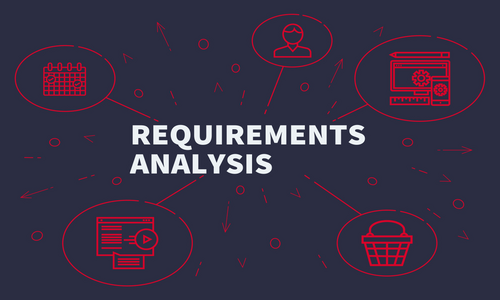Often there are differences between the product planned and created. The enormous resources and time invested in planning may not yield the exact results. Requirements Analysis is the most feasible tool to avoid such discrepancies. This process prevents any production-related issues in the future. It is performed at a project’s initial stage to ensure that a service or product meets the proposed consumer needs. This method is a visual language for clarifying stakeholders’ expectations and ensuring that a project aligns with them.

Jump ahead to
Define Requirements Analysis
Requirements Analysis is the method of determining a product’s needs and user expectations surrounding it. It is a teamwork comprising the equal participation of developers, stakeholders, customer managers, and end-users. They all come together to comprehend and finalize a product’s or service’s ultimate purpose. In other words, it is a process of identifying, validating, documenting, and managing the production system requirements.
What Are The Requirements Analysis Techniques?
Given below are the different means of conducting requirements analysis.
Gap analysis
This technique identifies the areas of improvement in a business. It is a comparative study of the desired business objectives and their current status. Optimizing the project pitfalls is the goal of analysts who apply this process. This method ensures that every business or product development activity aligns with the business needs. It provides a clear comparison between the targeted and existing state of the business.
BPMN
BPMN (Business Process Modeling Notation) allows easy comprehension of business processes through graphical representations. These graphs utilize specific elements and symbols to streamline complex business patterns. This technique facilitates the coordination of participants’ messages within an arena of relevant activities.
Flowcharts
Whether top-down, cross-functional, or linear in pattern, flowcharts effectively depict the sequence of project activities. They represent data flows and system interactions for easy understanding of even the team’s non-technical members. Flowcharts exhibit every vital aspect of a business process.
Data-flow diagram
Data-flow diagrams are visual presentations of complex processes and systems that cannot be explained in text format. These diagrams depict information flowing throughout a project’s lifecycle. They describe the relationships between various entities through standardized symbols and notations. Such a diagram consists of data stores, outputs, inputs, and every subprocess exhibiting data movement.
BMM(Business Motivation Model) is a powerful method of performing requirements analysis. It allows business decision-making according to global changes. Besides, studying consumer stories and use cases also helps prioritize consumer needs. Another effective way to better understand a project’s requirements is to create maps infused with visuals and storytelling. These maps direct a consumer’s objections, fears, or motivations.
When To Apply Requirements Analysis?
Requirements Analysis is essential to fulfill the following project management needs which are as follows:
- Determine project priorities
- Development costs calculation
- Streamline the project’s operations within a structure
Advantages Of Requirements Analysis
Investing time and money in executing requirements analysis to perfection always pays off in the following ways:
- Reduced rate of rework
- No miscommunication
- Faster delivery
- Finished product with few or no faults at all
- Team cooperation
- Discovery of innovation and growth opportunities
- Increased consumer satisfaction
Requirements Analysis Process
The following steps are essential for deriving the best results from requirements analysis.
Stakeholder analysis
The foremost step in conducting a requirements analysis is determining the prominent project stakeholders. Beforehand classification of stakeholders helps prioritize their expectations based on their level of importance and interest in a project.
Highly interested
Highly interested stakeholders refer to both project sponsors and consumers. Their expectations should occupy the top position on the list of priorities. Also, these stakeholders have a major influence on a project. To avoid future problems, it is best to communicate regularly with stakeholders who don’t have a strong say in the project but possess equal interests.
Less interested
Certain stakeholders are equally influential, like highly interested stakeholders, but they are not keen on the project. Meeting the interests of such individuals is a factor to consider while sorting out the requirements. On the other hand, some stakeholders neither hold a strong position nor are much interested in the project. In that case, it would be wise to maintain good relationships with them but not bother them excessively.
Stakeholder requirements
The next step is to categorize the expectations of stakeholders as have been classified previously. Their expectations determine how to go by a project and its requirements. It is important to identify and classify stakeholders’ objectives based on their relevance to project success.
A lack of clear communication with stakeholders would make the latter come up with requirements that do not fit that project. Not implementing what they desire would only lead to their dissatisfaction, thereby hampering the project. Contextual discussions with stakeholders are crucial to identify potential gaps in project scope. This can be done in varying ways:
- Interview all stakeholders individually to gain knowledge of their requirements and perspectives.
- Double-check the individual requirements with those of stakeholder groups while holding interview sessions with them.
- Study use cases to view the functionalities of a service or product from its end-users experience with it.
- Build prototypes of the end product or service to identify gaps before its launch. This helps prevent user dissatisfaction.
Categorize requirements
The identified requirements must cover the following three sections:
- Functional requirements -The requirements that determine a project’s success.
- Operational requirements- The vital operations for running a project
- Technical requirements- The technical issues that demand attention and solutions.
Record requirements
This rung of requirements analysis involves the feasibility evaluation of the requirements gathered in the earlier step. Defining and ranking each of them as per their significance in a project. Discussions with key stakeholders are essential at this stage to explore the project’s possible outcomes and choose priorities. This selection is necessary to stay within the project’s budget and resources without compromising its best interests. Analyzing the new system’s or product’s usability and reliability is crucial. This also helps in detecting gray areas.
Form an agreement
Finally, all these findings should be shared in writing with stakeholders as a document. The document must bear the signatures of previously classified stakeholder groups as their consent to the list of requirements. Thus, a requirements analysis document is the output of the entire procedure.
This knowledge is useful for project managers, business analysts, and other professionals. Training programs on PMI PBA Certification are feasible for studying the varying facets of project management, of which requirements analysis is one.
Summary
Requirements Analysis is the foundational teamwork process that eliminates uncertainty by clarifying every stakeholder expectation from the start. Learn the five essential steps from comprehensive Stakeholder Analysis and categorization to formal agreement that ensure product alignment. The article reveals powerful techniques like BPMN and Data-Flow Diagrams that visually solidify complex needs. Investing time in this analysis guarantees you reduce technical faults, accelerate product delivery, and minimize resource wastage.Transform ambiguity into clarity: Sign up for our next PMI Professional in Business Analysis (PMI-PBA) training session now!
FAQs on Requirements Analysis
1. What is Requirements Analysis?
It is the process of defining, documenting, validating, and managing the needs and expectations of a product or service with stakeholders.
2. Why is Requirements Analysis necessary?
It is necessary to prevent project failures, reduce costly rework, ensure the product meets customer needs, and align the project with strategic objectives.
3. When should Requirements Analysis be applied?
It must be applied at the initial stage of a project to determine priorities, calculate development costs, and streamline operations before execution.
4. What are the main benefits of Requirements Analysis?
Key benefits include faster delivery, reduced miscommunication, finished products with few faults, and increased consumer satisfaction.
5. What is the first step in Requirements Analysis?
The first step is Stakeholder Analysis, where prominent project stakeholders are identified and their expectations are prioritized.
6. What is the purpose of Gap Analysis in Requirements Analysis?
Gap analysis is a technique used to identify the areas of improvement by comparing the desired business objectives with the current status.
7. What are the three categories of requirements?
Requirements are typically categorized as Functional (what the system does), Operational (vital operations), and Technical (system and architecture needs).
8. What is BPMN in Requirements Analysis?
Business Process Modeling Notation (BPMN) is a technique that uses graphical representations to simplify and model complex business processes.
9. Who typically performs Requirements Analysis?
It is performed collaboratively by Business Analysts, Project Managers, developers, customer managers, and end-users.
10. How does Requirements Analysis reduce miscommunication?
It serves as a visual language to clarify and document all stakeholders’ expectations upfront, minimizing future confusion and disputes.



